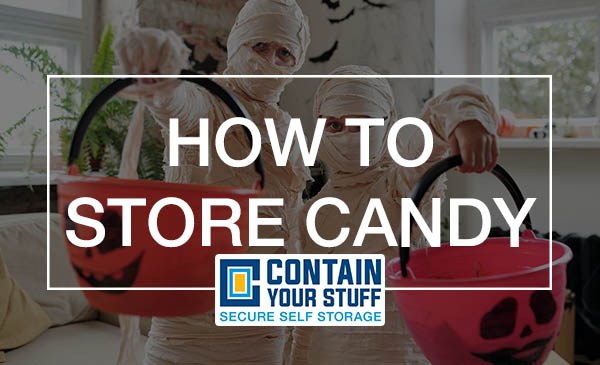
10 Chores Done in 10 Minutes
October 19, 2023
Storage Units For The Holiday Season
November 16, 2023Halloween is here in Nanaimo, and that means candy. But how do you store all the candy that your kid couldn’t possibly finish? Here are some tips to ensure your sweets remain sweet. If you are really looking to hide your candy, a storage unit makes a great place.
How to Store Candy
Candy is a delicious treat that deserves proper storage care to maintain its freshness and quality over time. However, candy can easily become stale, melt, grow mold, or pick up unwanted flavors and odors if not stored correctly. Proper candy storage requires addressing factors like temperature, humidity, light exposure, and oxygen exposure that can negatively impact your candy.
The right storage methods allow you to keep candy fresh for longer. This prevents waste, protects candy, and ensures you can enjoy it at peak deliciousness. Well-stored candy maintains ideal texture, retains moisture, resists sugar bloom, and keeps its intended flavors and aromas.
Unopened Candy
For maximum shelf life, unopened candy should be stored properly according to the specific type of candy. In general, an unopened package of regular candy like chocolate bars, hard candy, gum, or gummies can last 6-12 months past the expiration date if stored correctly.
However, storage conditions can impact the shelf life. Temperature and humidity are two of the biggest factors. Unopened candy should be kept in a cool, dry place away from direct sunlight and heat sources. An ideal storage temperature is between 60°F to 75°F. High heat causes candy bars and chocolate to melt, and humidity causes sticky surfaces or sugar bloom. Storing candy in the refrigerator is not necessary and can actually lead to sugar bloom on chocolate.
Some candies like licorice, marshmallows, and candy corn are more sensitive to heat and humidity than chocolate. Their optimal storage conditions are 60°F or cooler with lower humidity of 55% or less. These types of candy have a shorter shelf life of 3-6 months past the expiration date.
Opened Candy
Once candy is opened, it requires extra care and attention to keep it fresh and tasty. This is because opened candy is more susceptible to oxygen exposure, temperature fluctuations, and humidity changes.
Oxygen causes oxidation, which can make candy stale, alter flavors, and lead to decreased quality. Limiting air exposure by resealing opened candy or storing it in an airtight container helps reduce oxidation. Hard candies like lollipops are especially prone to absorbing moisture and getting sticky when continuously exposed to air.
Temperature also impacts opened candy. Heat can cause chocolate products or candies with cream fillings to melt or get warped in shape. It may also speed up chemical reactions that degrade flavors and textures. Cool, room temperature storage between 60-72°F is ideal. Avoid temperature extremes or fluctuations.
High humidity introduces moisture that makes candies sticky, causes sugar to clump, and encourages microbial growth like mold. Storing opened candy at a consistent, cool temperature along with keeping humidity around 35-60% helps prevent moisture issues.
With a little extra care, opened candy can stay fresh for extended periods. Resealing containers, regulating temperature and humidity levels, limiting oxygen exposure, and proper storage setups are the keys to enjoying candy long after it’s opened. Taking these protective measures allows you to indulge in your favorite sweets worry-free.




